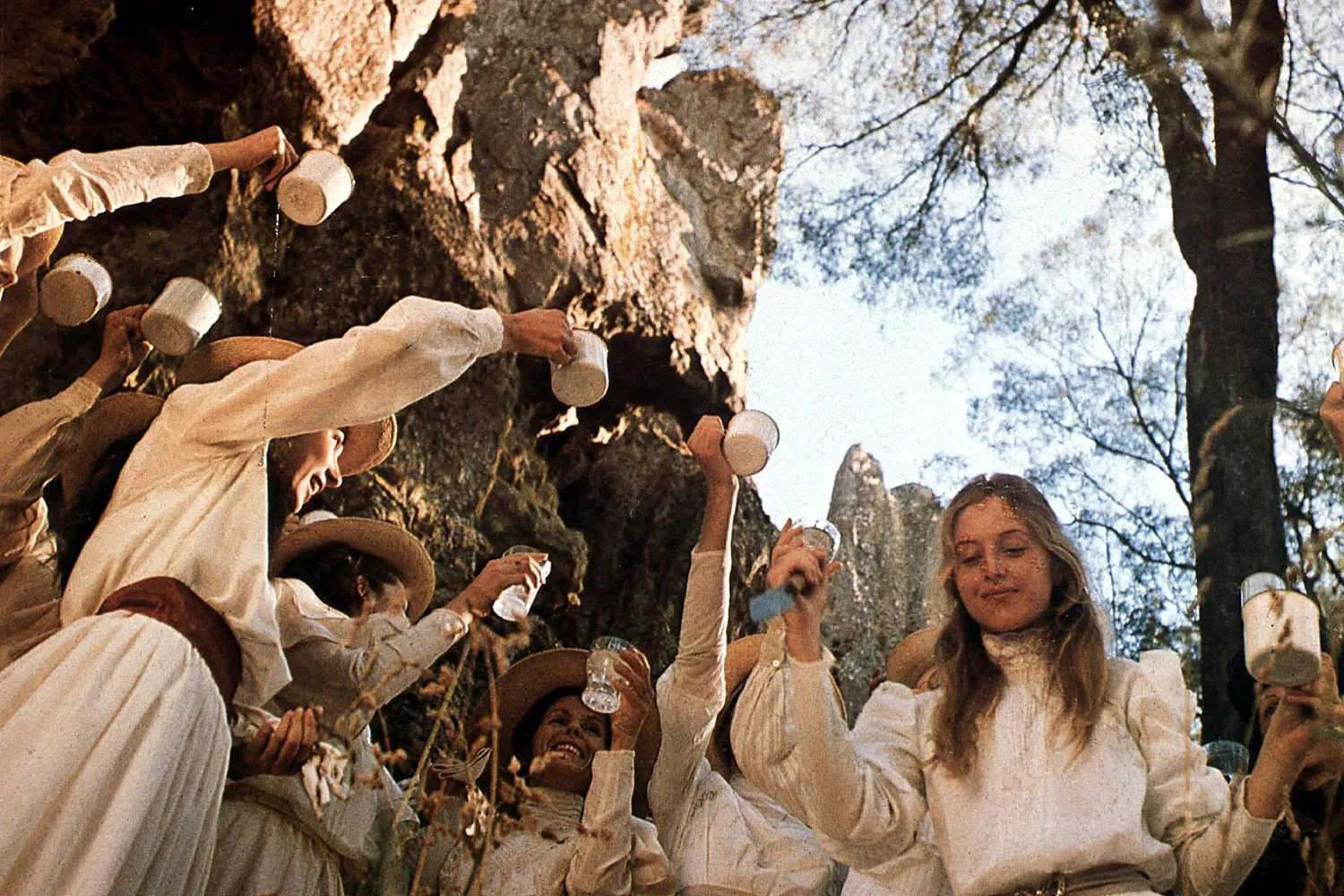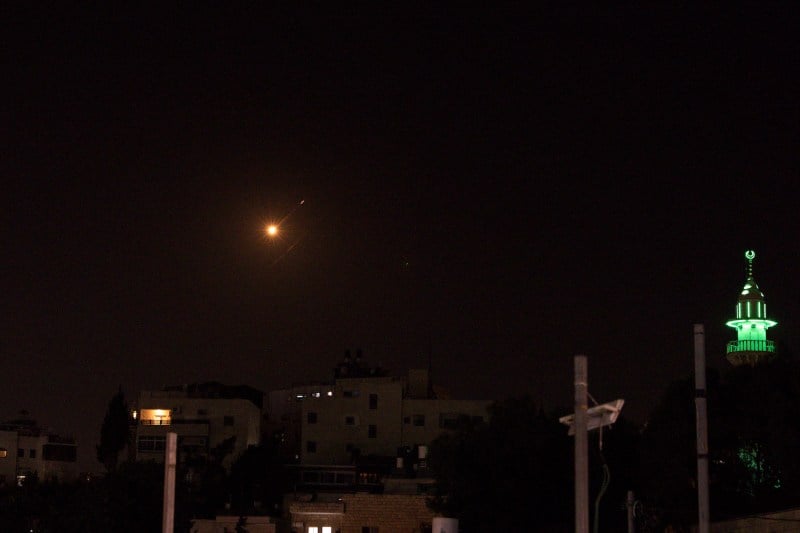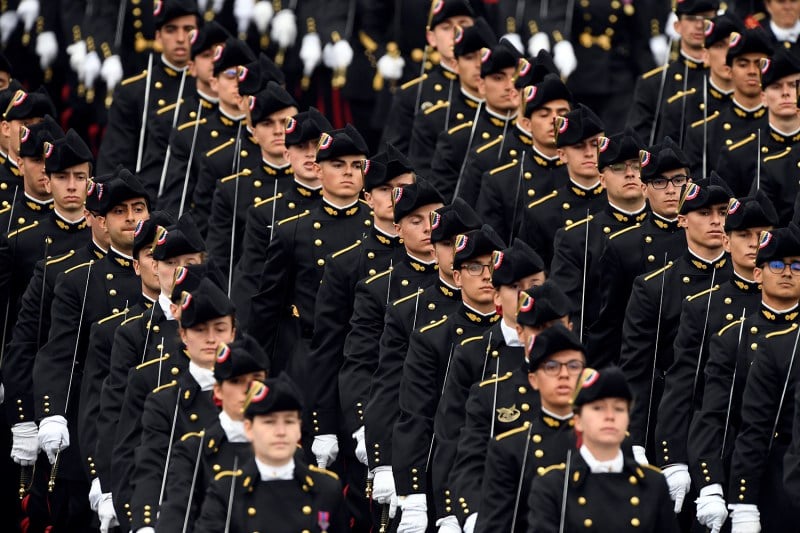Australia’s First Art Film

Review
Australia’s First Art Film
“Picnic at Hanging Rock” has kept audiences guessing for 50 years.
A still from Peter Weir’s “Picnic at Hanging Rock,” released in 1975. United Archives via Getty Images
Fifty years ago, the film movement known as the Australian New Wave summited a peak from which, in some ways, it has never returned. Picnic at Hanging Rock, crowned the best Australian movie of all time by Time Out, is currently taking an anniversary victory lap in North American cities with a remastered print, while a stage adaptation of the source novel is underway in Sydney. The continued affection for the picture is no surprise to anyone who has seen it, as the eerie, mysterious work is legendary for its spellbinding style. One watches this movie about a group of Victorian-era schoolgirls who disappear during a pleasant outing, and immediately must know more—did this strange tale actually happen, like the opening title card suggests? And, if so, what the heck really transpired out there in the bush?
That disorientation isn’t just the audience’s. The director, six-time Academy Award-nominee and 2022 Honorary Oscar winner Peter Weir, confessed that when he met Picnic’s author Joan Lindsay, he asked her if the story was true, and what happened at the end. He never got a conclusive answer. He leaned into the ambiguity, creating a film that turns viewers into detectives, making them more attuned to richer themes in addition to mere plot points. You can read Picnic at Hanging Rock as a story about fruitless police work or even some zany sci fi narrative. Or you can interpret it to be a warning against colonialism, or perhaps a reminder that, though nature is beautiful, it is forever red in tooth and claw. The point is that it will keep you ruminating after the credits roll.
Fifty years ago, the film movement known as the Australian New Wave summited a peak from which, in some ways, it has never returned. Picnic at Hanging Rock, crowned the best Australian movie of all time by Time Out, is currently taking an anniversary victory lap in North American cities with a remastered print, while a stage adaptation of the source novel is underway in Sydney. The continued affection for the picture is no surprise to anyone who has seen it, as the eerie, mysterious work is legendary for its spellbinding style. One watches this movie about a group of Victorian-era schoolgirls who disappear during a pleasant outing, and immediately must know more—did this strange tale actually happen, like the opening title card suggests? And, if so, what the heck really transpired out there in the bush?
That disorientation isn’t just the audience’s. The director, six-time Academy Award-nominee and 2022 Honorary Oscar winner Peter Weir, confessed that when he met Picnic’s author Joan Lindsay, he asked her if the story was true, and what happened at the end. He never got a conclusive answer. He leaned into the ambiguity, creating a film that turns viewers into detectives, making them more attuned to richer themes in addition to mere plot points. You can read Picnic at Hanging Rock as a story about fruitless police work or even some zany sci fi narrative. Or you can interpret it to be a warning against colonialism, or perhaps a reminder that, though nature is beautiful, it is forever red in tooth and claw. The point is that it will keep you ruminating after the credits roll.
Many scholars argue that the first feature-length movie was an Australian production, The Story of the Kelly Gang, which opened in 1906. Movie-making in Australia continued off-and-on over the years—future Hollywood star Errol Flynn caught the acting bug in a local production before departing for London—and by the 1950s and ’60s there were an increasing number of British and American films shot on location “down under.” (Not all of these are masterpieces. For every A Town Like Alice, the Peter Finch and Virgina McKenna-led romantic adventure, there was something like Kangaroo, a snoozy outback drama from director Lewis Milestone.) But in the late 1960s, the Australian film industry was pretty much nonexistent. That was around when the Australian government created a commission to kickstart local productions which quickly led to some innovative titles.
The first two movies from this initiative to make an international mark came in 1971: Walkabout and Wake in Fright. These can still be seen as lodestars for many of the great Australian movies that followed. Walkabout is about a teenage girl and her younger brother from the city who are marooned in the outback and learn to coexist with the natural world with the aid of an Indigenous guide. The movie may suffer a bit from “noble savage” tropes, but at the time this was quite a rare representation. Even into the 1990s and with the release of The Adventures of Priscilla, Queen of the Desert, we see movies wherein European-descendent Australians get out into the hinterlands and are free to transform into their true selves.
Movie posters from Australian films in the 1970s.
Wake in Fright, however, takes a much darker approach, warning that if you travel too far into the bush, you’ll find that the environment turns people into violent, drunken lunatics. This extremely tense, bonkers movie doesn’t have vehicular stunts in the way the Mad Max series does, but that renegade, unpredictable vibe (later dubbed Ozploitation) is just as forceful here as with anything set in the collapsed social order of Australia’s most famous movie franchise.
It’s important to note, however, that neither of these seminal films was made by an Australian. Walkabout’s director Nicolas Roeg was British (a former cameraman who cut his teeth on Lawrence of Arabia) and Wake in Fright’s Ted Kotcheff is Canadian. (His career is quite diverse; after the aggressive Wake in Fright, he made the youthful comedy The Apprenticeship of Duddy Kravitz, then the first in the Rambo series, First Blood, then the idiotic-but-strangely-likable corpse comedy Weekend at Bernie’s. We all contain multitudes!)
A scene from Weir’s The Cars That Ate Paris.
Luckily, up stepped the Sydney-born Weir. His first feature, 1974’s The Cars That Ate Paris, trucks considerably in the Ozploitation mode, grabbing you by the throat with that strange title and bizarre production design.
The Cars That Ate Paris, like Wake in Fright, is an Australian spin on a Twilight Zone-like story where a small town is keeping a tremendous secret. This time, the area around the village is booby trapped to create auto accidents, which the locals profit from in strange and insidious ways. It’s clearly meant to be a metaphor, but it also has plenty of action. It was not a hit—though its critical reputation has grown, and you can find it on a list of Stanley Kubrick’s faves—but from it Weir gained enough experience to make Picnic at Hanging Rock.
Weir’s proclivity for daffy ideas and grippingly shot car crashes adds to the unusual tone to Picnic at Hanging Rock, which, in lesser hands, could be a very frilly, genteel affair. The first few scenes make it seem like a typical BBC-style prestige adaptation. We open on Valentine’s Day in the year 1900 at an “educational establishment for young ladies” run by Mrs. Appleyard (Rachel Roberts), a very strict woman trying to keep a firm grip of English-style propriety in an environment where it is not really suited. For the holiday, the girls will be allowed an educational, naturalist outing to Hanging Rock, a former volcano in Victoria known as Ngannelong to Indigenous Australians. (All get to go but Sara, played by Margaret Nelson, an independent thinker from modest means.) When the group gets there, they find that their pocket watches stop working (a little plot point M. Night Shyamalan yanked years later for the film Old) and everyone gets real drowsy.
Scenes from Picnic at Hanging Rock. BEF Film Distributors
Soon, four girls decide to take a walk, led by Miranda (Anne-Louise Lambert), a charismatic young woman who may or may not have a “special relationship” with Sara back at the school. We pull back to discover that the girls in their flowing white dresses are being spied upon by a young English gentleman in uncomfortable looking clothing (Dominic Guard) and his down-to-earth valet (John Jarratt), whom we later discover is Sara’s brother. The girls are drawn, almost hypnotized, up the rocky cliffside and … vanish.
There are some additional twists and turns after this, but that is basically it. It doesn’t sound like much, but the ineffable, intangible strangeness to this all has been beguiling and bewildering audiences for 50 years.
Part of that is due to the specificity of the scenario—the elegant, shipped-from-Europe furniture in the school against the cicadas and bees and black spiders lurking for those virginal girls in white soon swallowed by the heat and dust. There’s the exquisite use of language—memorized Longfellow verses and French lessons—later turned to frenzied cries of the missing girls’ names, then frightened screams from survivors of the traumatizing incident. Also the juxtaposition of music—warhorses from the Western classical canon like the “Romance” movement from Mozart’s “Eine Kleine Nachtmusik” and the second movement of Beethoven’s “Emperor Concerto” weaved in among original recordings by New Age artist Gheorghe Zamfir (“Master of the Pan Flute,” as some might recall from 1990s TV). The recurring ethereal theme on pan flute connotes a twilight of pagan sprites, while the accompanying organ—almost bluesy—adds a bit of swagger, a bit of baseness.
Gheorghe Zamfir plays the pan flute, circa 1978.David James Bartho/Fairfax Media via Getty Images
The push-pull of Zamfir’s theme gets to one of the prime unspoken elements of this movie: It is one of the great investigations into what critic Roger Ebert called “buried sexual hysteria.”
It’s hard to know how much author Joan Lindsay, age 70 at the book’s publication in 1967, was inspired by E.M. Forster’s novel A Passage to India. However, the girls from Appleyard College and their elderly chaperone in Picnic at Hanging Rock do share similarities with Miss Quested and Mrs. Moore at the Marabar Caves, in which a stark encounter with the infinite—and a confrontation with their sexuality and mortality—shake the women of opposite ages to their core. There is no shortage of prurient readings of Picnic (this is a particularly good one), and what’s great about the movie is there is no possible way to get it “wrong.” Lindsay, who attended a school similar to Appleyard in her youth and pinched the title from a painting by William Ford, was reportedly inspired by vivid dreams to write the story. Though she never confirmed or denied if the events were based on truth, most now agree that it is fiction.
Picnic at Hanging Rock won its cinematographer, Russell Boyd, a BAFTA award, and showed the international community that Australia could make art films of its own. Weir maintained a busy schedule, following up with The Last Wave, in which Richard Chamberlain plays a lawyer entangled in a case with Indigenous Australians who begins having apocalyptic visions. Then came the television film The Plumber, a nasty thriller about a belligerent worker in a modern housing complex, then a major international release, the tragic World War I drama Gallipoli, which starred Mel Gibson and was produced by Robert Stigwood, the Australian-born music producer behind the Bee Gees and RSO Records. It came out just a year after Bruce Beresford’s Breaker Morant, another Australian war film, and the one-two punch did a great deal to enhance visibility of Australian history.
Weir (center) during filming of Picnic at Hanging Rock.BEF Film Distributors
Weir followed up Gallipoli with a second Mel Gibson collaboration, The Year of Living Dangerously, one of the first major co-productions between Australian and Hollywood companies. Co-starring Sigourney Weaver and Linda Hunt (who won an Oscar for her role), the movie concerns a group of foreign journalists in Indonesia during an attempted coup in 1965. After this, Weir left for Hollywood where he made the Amish-set mystery Witness (his first Academy Award nomination), then other big hits like Dead Poets Society, Fearless, The Truman Show, and Master and Commander: The Far Side of the World.
If one squints hard enough, one can find commonalities with Picnic in all of these movies. The detective work in Witness; the stultifying school in Dead Poets Society; the randomness of who lives and who dies in Fearless; the sense that someone or something is always watching in The Truman Show; and the beauty and horror of nature in Master and Commander all have their roots in Weir’s 1975 film. Round out the filmography with The Mosquito Coast, Green Card, and The Way Back and we have three more stories about people trying to adapt to a new environment, much like the teachers and pupils of Mrs. Appleyard’s school. Throughout his tremendous career, Weir always kept part of himself atop Hanging Rock.
Jordan Hoffman is a film critic and entertainment journalist living in Queens, New York. X: @jhoffman
More from Foreign Policy
-

Periodic table The Periodic Table of States
The org chart for a post-Westphalian world.
-

French Emperor Napoleon Bonaparte leads the final assault by the Imperial Guard before his defeat at the Battle of Waterloo in what is today Belgium, on June 18, 1815. The Cost of Ignoring Geopolitics
Like Napoleon and the Ming dynasty, Europe is paying the price for strategic blindness.
-

Donald Trump holds solar eclipse glasses. What I Got Wrong About Trump’s Second Term
I didn’t entirely see this coming. Here’s why.
-

A woman walks past an advertisement for the Russian army at a bus stop. Russia Is Only Winning Inside Trump’s Head
As Russians will tell you, the reality on the ground looks very, very different.














Join the Conversation
Commenting on this and other recent articles is just one benefit of a Foreign Policy subscription.
Already a subscriber?
.
Subscribe
Subscribe
View Comments
Join the Conversation
Join the conversation on this and other recent Foreign Policy articles when you subscribe now.
Subscribe
Subscribe
Not your account?
View Comments
Join the Conversation
Please follow our comment guidelines, stay on topic, and be civil, courteous, and respectful of others’ beliefs.
Change your username |
Log out
Change your username:
CANCEL
Confirm your username to get started.
The default username below has been generated using the first name and last initial on your FP subscriber account. Usernames may be updated at any time and must not contain inappropriate or offensive language.